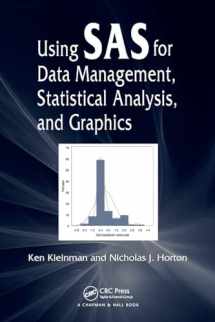
Using SAS for Data Management, Statistical Analysis, and Graphics
Book details
Summary
Description
Quick and Easy Access to Key Elements of Documentation
Includes worked examples across a wide variety of applications, tasks, and graphics
A unique companion for statistical coders, Using SAS for Data Management, Statistical Analysis, and Graphics presents an easy way to learn how to perform an analytical task in SAS, without having to navigate through the extensive, idiosyncratic, and sometimes unwieldy software documentation. Organized by short, clear descriptive entries, the book covers many common tasks, such as data management, descriptive summaries, inferential procedures, regression analysis, multivariate methods, and the creation of graphics.
Through the extensive indexing, cross-referencing, and worked examples in this text, users can directly find and implement the material they need. The text includes convenient indices organized by topic and SAS syntax. Demonstrating the SAS code in action and facilitating exploration, the authors present example analyses that employ a single data set from the HELP study. They also provide several case studies of more complex applications. Data sets and code are available for download on the book’s website.
Helping to improve your analytical skills, this book lucidly summarizes the features of SAS most often used by statistical analysts. New users of SAS will find the simple approach easy to understand while more expert SAS programmers will appreciate the invaluable source of task-oriented information.


We would LOVE it if you could help us and other readers by reviewing the book
Book review



